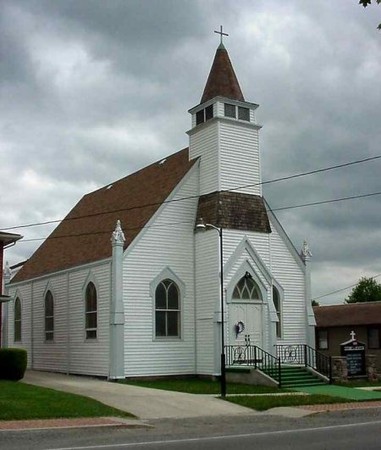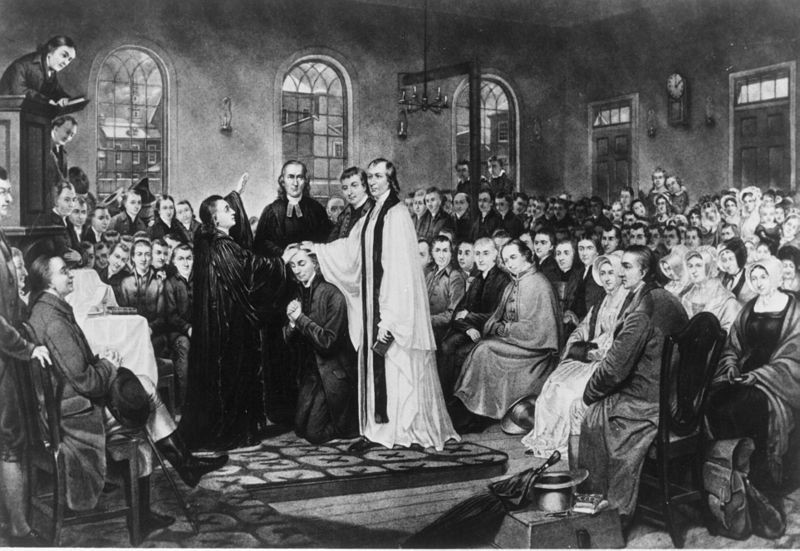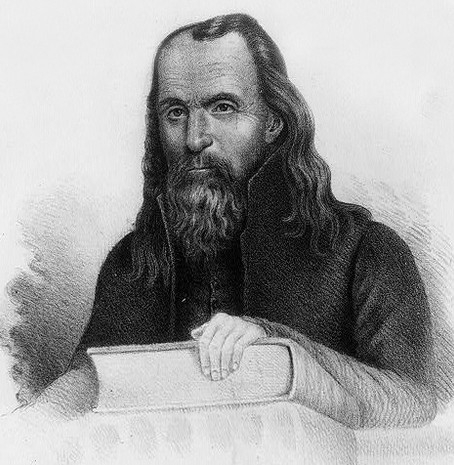Beverly United Methodist Church
Introduction
Text-to-speech Audio
Images
Modern photo of the Beverly United Methodist Church.

1882 engraving depicting Francis Asbury's ordination as bishop.

Lorenzo Dow, who preached in Beverly in the 1800s.

Backstory and Context
Text-to-speech Audio
The Methodist congregation of what is now Beverly, West Virginia formally organized in 1786, the same year that the Virginia Assembly voted to form Randolph County and name Beverly as its seat. Although the congregation’s first church, a log building on Court Street, was built at an unknown date it was most likely shortly after the congregation’s formation since early records indicate it was in this structure that Bishop Francis Asbury preached during his visit to the town in 1788. One of the Methodist Episcopal Church’s two first bishops in the United States, Asbury was a key figure in the Second Great Awakening, a period of religious revival characterized by enthusiastic faith gatherings, a deemphasis on traditional church hierarchies, and the prioritizing of a more personal relationship to the divine. Asbury traveled throughout the borderlands of the British colonies and later United States over the course of forty five years as a preacher in North America, during which time he founded several schools for Methodist ministers and kept a detailed journal that remains one of the best sources on life in the Appalachians in the late eighteenth century. In one such journal entry he records his visit to the area that is now Beverly, characterizing the community’s inhabitants in starkly negative terms: “good moralists they are not, and good Christians they can not be unless they are better taught.”[1]
After Asbury’s visit to Beverly the next itinerant Methodist preacher in the town was the Reverend Lorenzo Dow, who traveled extensively throughout the region in the early 1830s. Dow, another prominent figure of the Second Great Awakening, traveled first across the Atlantic to the United Kingdom before returning to preach across the Appalachian region. During his time in the UK Dow caused considerable controversy for his hypnotic manner of speaking and unkempt dress, as well as the enthusiastic response of the worshippers who attended the camp meetings he held in both England and Ireland. Upon his return to the United States Dow began preaching across the southern United States, where he was noted for appearing without warning in towns from Virginia to Georgia simply to announce that he would return for a revival on the same date the following year. While his staunch opposition to slavery often made him unwelcome in such towns, it appears from local accounts that he was welcomed enthusiastically by the residents of Beverly on the several occasions that he appeared there.
Shortly after Dow’s visits to the area, the Reverend Samuel Clawson arrived to preach a sermon to the Methodist congregation there. Noted for his eccentricities in the pulpit, Clawson preached across the Pittsburgh area before joining the West Virginia Conference after the new state’s formation in 1863. During his time in the Beverly area, Clawson made a particularly strong stand against the spread of Primitive Baptist Universalism in the community. Practitioners of this theology (which argued against the existence of Hell) were known colloquially as “No Hellers” and could be found in entrepots across Appalachia, where they were noted for interrupting the sermons of preachers who threatened their congregation with the torments of eternal damnation. Upon hearing that one of those entrepots was located in Beverly, Clawson proclaimed in his sermon to the Methodists of the town that if the “gang here who call themselves ‘No Hellers’…speak to me here tonight or any other time, I will knock you higher than the Tower of Babel.”[2] So, on that occasion, apparently, the No Hellers held their tongues.
The Methodist congregation to which these preachers spoke lost their original church building during the American Civil War when federal troops occupying Beverly dismantled it and used the materials to build small wooden huts as their winter quarters. After the war the congregation constructed a temporary replacement for their original church at the same location, which in turn lasted over two decades before Beverly’s Methodists could afford to build better accommodations. This they did in 1890 on Main Street across from the Beverly Presbyterian Church. This church, the structure still in use today, was built in the Gothic Revival style. The decorative finials on the columns at the church’s front is especially representative of this style, as are the pointed arches and drip molding over the structure’s windows.
[1] Bosworth, 274.
[2] Bosworth, 272.
Sources
Bosworth, Albert Squire. A History of Randolph County, West Virginia, from Its Earliest Exploration and Settlement to the Present Time. Elkins, WV, 1916.
“Clawson, Samuel.” McClintock and Strong Biblical Cyclopedia Online. Accessed September 7, 2019. https://www.biblicalcyclopedia.com/C/clawson-samuel.html.
Dorgan, Howard. “The ‘No Heller’ Baptists of Central Appalachia: Primitives Adapt to Universalism.” Journal of the Appalachian Studies Association6 (1994): 81–88.
Dow, Lorenzo. The Eccentric Preacher: or A Sketch of the Life of the Celebrated Lorenzo Dow, Abridged from His Journal; and Containing the Most Interesting Facts in His Experience. Lowell: E.A. Rice & Co., 1841.
Heyrman, Christine Leigh. Southern Cross: the Beginnings of the Bible Belt. Chapel Hill: Univ. of North Carolina Press, 2006.
Maxwell, Hu. The History of Randolph County, West Virginia. From Its Earliest Settlement to the Present, Embracing Records of All the Leading Families, Reminiscences and Traditions. Morgantown, WV: Acme Publishing Co., 1898.
“The Beverly Methodist Church.” Historic Beverly West Virginia. Historic Beverly Preservation, Inc. Accessed September 7, 2019. http://www.historicbeverly.org/builds/methchurch.htm.
Wigger, John H. Taking Heaven by Storm: Methodism and the Popularization of American Christianity, 1770-1820. Oxford University Press, 1994.
Historic Beverly Preservation, Inc.
Wikipedia
Wikipedia
